 |
 |
 |
| |
Gap Between Oral and Injectable PrEP Awareness in US Transgender Women
|
| |
| |
HIVR4P 2024, Fifth HIV Research and Prevention Conference, October 6-10, 2024, Lima
Mark Mascolini
Most transgender women in a nationwide US group know about daily oral preexposure prophylaxis (PrEP) to prevent HIV infection, but half of sexually active trans women in the US never heard of long-acting (LA) injectable PrEP [1]. This study by Erin Cooney and colleagues at Johns Hopkins University also found suboptimal overall PrEP uptake and adherence.
Transgender women in the US and across the globe bear a disproportionate burden of HIV infection [2,3]. Cooney cited research showing high overall awareness of and interest in PrEP among US transgender women [4-7], but uptake and adherence remain low.
ENCORE, an ongoing national observational cohort study, enrolled 2506 trans women not living with HIV in the United States and Puerto Rico. Observational analysis of ENCORE data seeks to explore HIV incidence, risk factors, and syndemic conditions among these women. Twice yearly visits including a survey and HIV test (by dried blood spot or oral fluid) can be done remotely. Participants enrolled between April 2023 and August 2024 after recruitment by community partners, via dating apps, and through machine learning-based ad services.
Analysis of PrEP awareness, uptake, persistence, and adherence involved 1620 transgender women not living with HIV who were sexually active or had risk factors that qualified them for PrEP. While 42% of the 1620 participants were under 30 years old, 35% were 30 to 39, and 23% were 40 or older. Whereas 61% of the study group were non-Hispanic white, 9% were non-Hispanic black, 6% Hispanic white, 1% Hispanic black, 12% non-Hispanic multiracial, and 10% Hispanic multiracial. About 1 in 10 women (9%) had a rural zip code. Only 6% a self-reported sexually transmitted infection (STI) diagnosis in the last 6 months, a finding reflected in proportions of women who saw themselves at no risk for HIV infection (17%), at low risk (50%), at medium risk (24%), or at high risk (9%).
Most women (61%) used an LGBTQ health clinic, almost half (49%) rated themselves food-insecure, and one quarter (24%) said they engaged in sex work or survival sex (sex work made necessary by extreme need).
A large majority of these 1620 transgender women, 91%, had heard of pill-based PrEP, but only 49% knew about injectable LA PrEP (P < 0.001). A little over one third of these 1620 women, 36%, had ever used oral PrEP, while only 2% had tried LA PrEP (P < 0.001). While one quarter of the study group (26%) used oral PrEP in the last 6 months, only 1% received injectable LA PrEP in that time (P < 0.001). Whereas 19% of women in the 1620-person study group were adherent to oral PrEP, 1% of 1620 self-reported adherence to LA PrEP (4 or more pills in the last week for oral PrEP; 9 or fewer weeks since their last LA injection).
Among the 32 women who ever used LA PrEP, median age stood at 32 years (range 21 to 59), 6 (19%) identified as black and 11 (34%) as Hispanic. Twenty-four women used LA PrEP in the past 6 months, and 4 of them (17%) got their shot a week or more late.
Among 1479 women aware of oral or LA PrEP, Poisson regression analysis determined that, compared with ages 18 to 29, all other age groups predicted more likely PrEP uptake (adjusted prevalence ratio [aPR] 1.27 for 30 to 39 years, 1.32 for 40 to 49 years, 1.60 for 50 or older). Compared with all other racial/ethnic groups, black participants proved more likely to start PrEP (aPR 1.14); Hispanic ethnicity had a similar impact on PrEP uptake (aPR 1.17).
Other factors independently associated with starting PrEP in this analysis were having an STI in the past 6 months (aPR 1.44), self-perceived low, medium, or high risk of HIV versus no risk (aPRs 1.37, 1.63, 1.32), getting care at an LGBTQ-specific clinic (aPR 1.32), receiving HIV prevention material specifically aimed at trans people (aPR 1.52), getting gender hormone therapy in the prior 6 months (aPR 1.48), and each 1-point higher gender pride score (aPR 1.02). This analysis tied only one factor to a lower chance of starting PrEP-living in a rural zip code (aPR 0.70).
Two sociodemographic variables predicted greater risk of PrEP nonadherence: household food insecurity (aPR 1.38) and income from sex work or survival sex (aPR 1.61). Being a US citizen predicted lower risk of nonadherence (aPR 0.40). Variables not tied to nonadherence in this analysis were age, black race, and Hispanic ethnicity.
The Johns Hopkins researchers called for more work to boost awareness of LA PrEP among transgender women so they can choose from all available PrEP options. They believe "the greatest implementation challenge for PrEP in general is bridging the gap between awareness and uptake," especially in programs tailored to young and rural trans women. And they proposed that melding PrEP services with gender-affirming care could widen PrEP uptake.
References
1 Cooney E, Poteat TC, Stevenson M, et al. The persistent chasm between PrEP awareness and uptake: characterizing the biomedical HIV prevention continuum in a nationwide cohort of transgender women in the United States. HIVR4P 2024, Fifth HIV Research and Prevention Conference, October 6-10, 2024, Lima. Abstract PRC137.
2. Baral SD, Poteat T, Stromdahl S, Wirtz AL, Guadamuz TE, Beyrer C. Worldwide burden of HIV in transgender women: a systematic review and meta-analysis. Lancet Infect Dis. 2013;13:214-222. https://www.thelancet.com/journals/laninf/article/PIIS1473-3099(12)70315-8/abstract
3. Becasen JS, Denard CL, Mullins MM, Higa DH, Sipe TA. Estimating the prevalence of HIV and sexual behaviors among the US transgender population: a systematic review and meta-analysis, 2006-2017. Am J Public Health. 2019;109(1):e1-e8. https://ajph.aphapublications.org/doi/10.2105/AJPH.2018.304727?url
4. Poteat T, Wirtz A, Malik MT, et al. T. A gap between willingness and uptake: findings from mixed methods research on HIV prevention among black and Latina transgender women. J Acquir Immune Defic Syndr. 2019;82:131-140. https://www.ncbi.nlm.nih.gov/pmc/articles/PMC7807529/
5. Wilson EC, Turner CM, Arayasirikul S, Lightfoot M, Scheer S, Raymond HF, Liu A. Disparities in the PrEP continuum for trans women compared to MSM in San Francisco, California: results from population-based cross-sectional behavioural surveillance studies. J Int AIDS Soc. 2020 Jun;23:e25539. https://www.ncbi.nlm.nih.gov/pmc/articles/PMC7325513/
6. Malone J, Reisner SL, Cooney EE, et al. Perceived HIV acquisition risk and low uptake of PrEP among a cohort of transgender women with PrEP indication in the eastern and southern United States. J Acquir Immune Defic Syndr. 2021;88:10-18. https://journals.lww.com/jaids/abstract/2021/09010/perceived_hiv_acquisition_risk_and_low_uptake_of.3.aspx
7. Morris E, Teplinskaya A, Olansky E, Rinderle JK, Chapin-Bardales J. Characteristics associated with pre-exposure prophylaxis discussion and use among transgender women without HIV infection-National HIV behavioral surveillance among transgender women, seven urban areas, United States, 2019-2020. MMWR Suppl 2024;73(Suppl-1):9-20. DOI: http://dx.doi.org/10.15585/mmwr.su7301a2
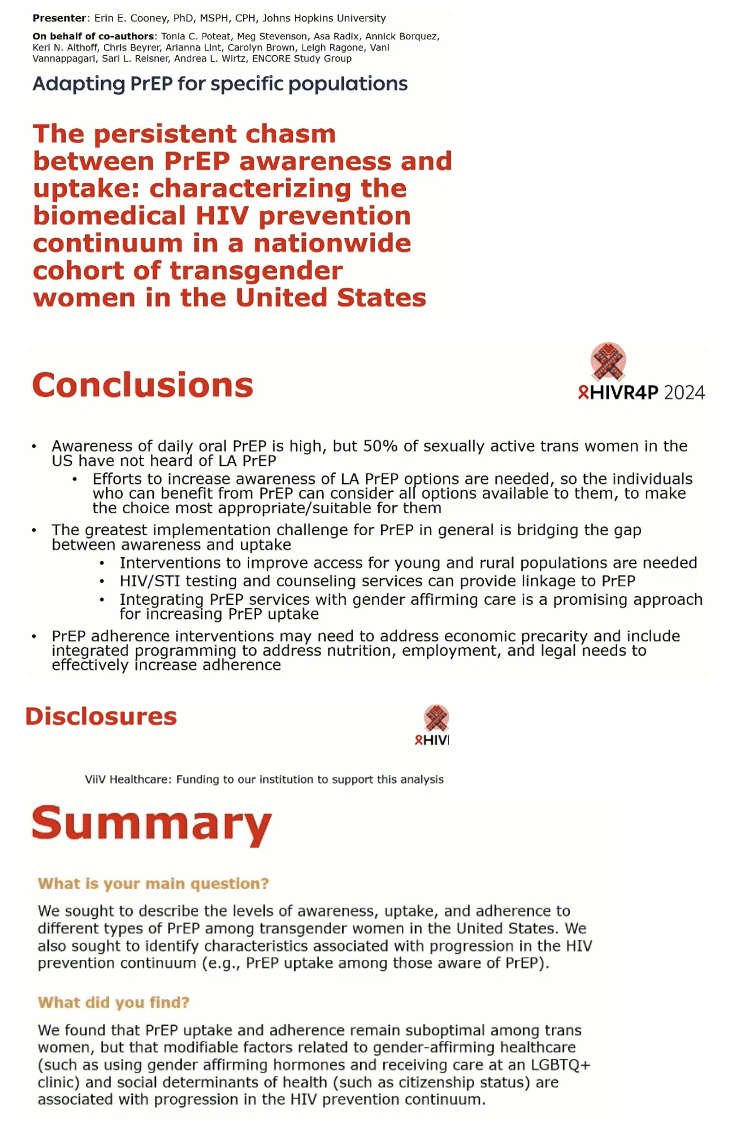
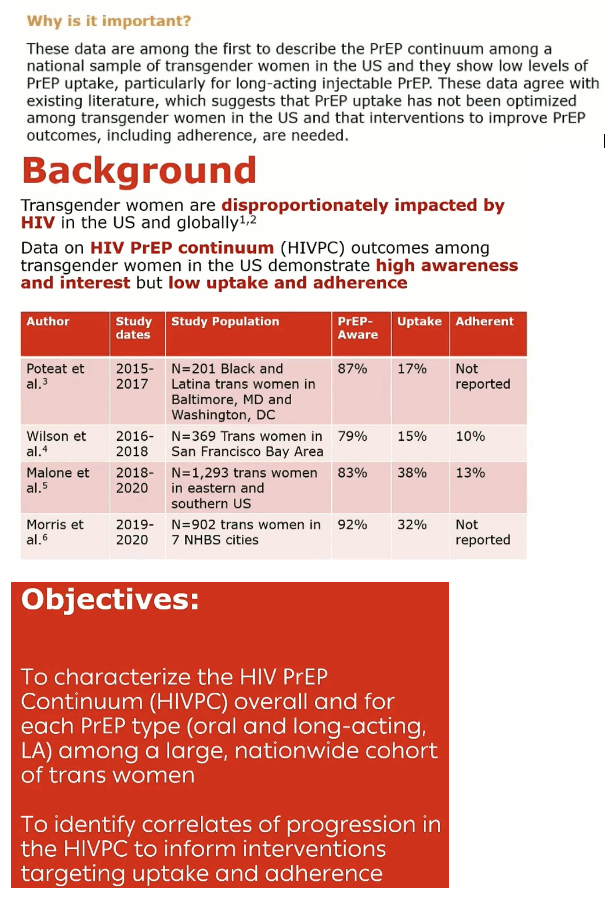
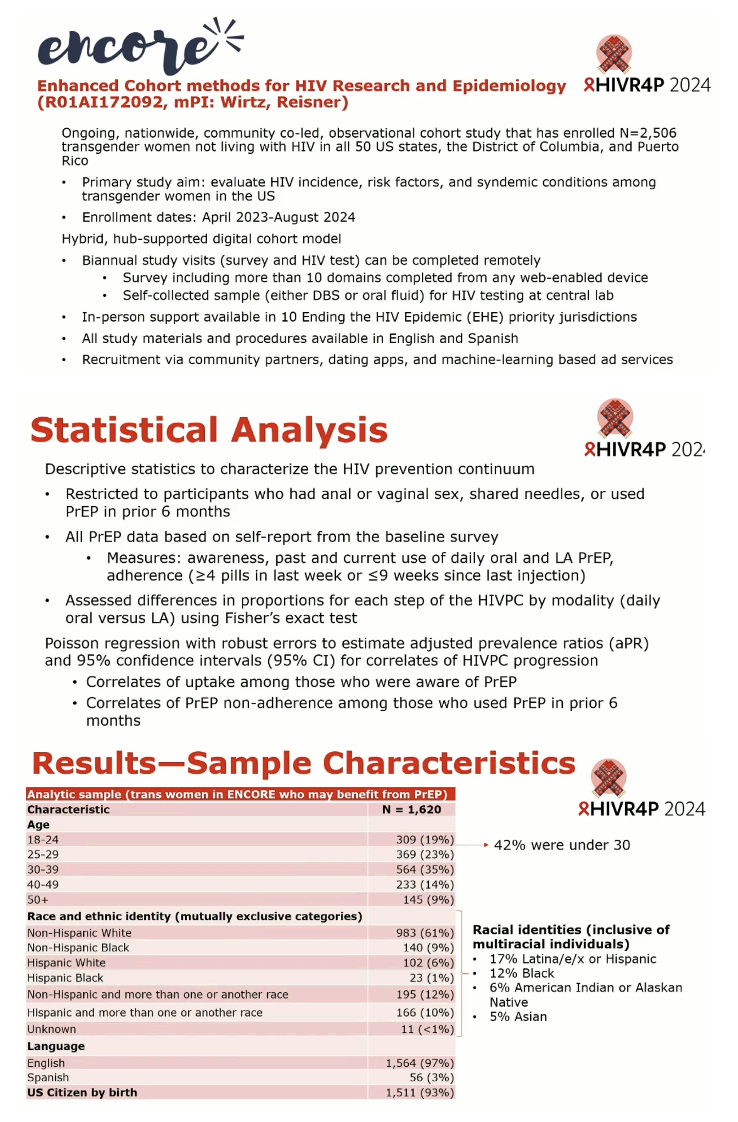
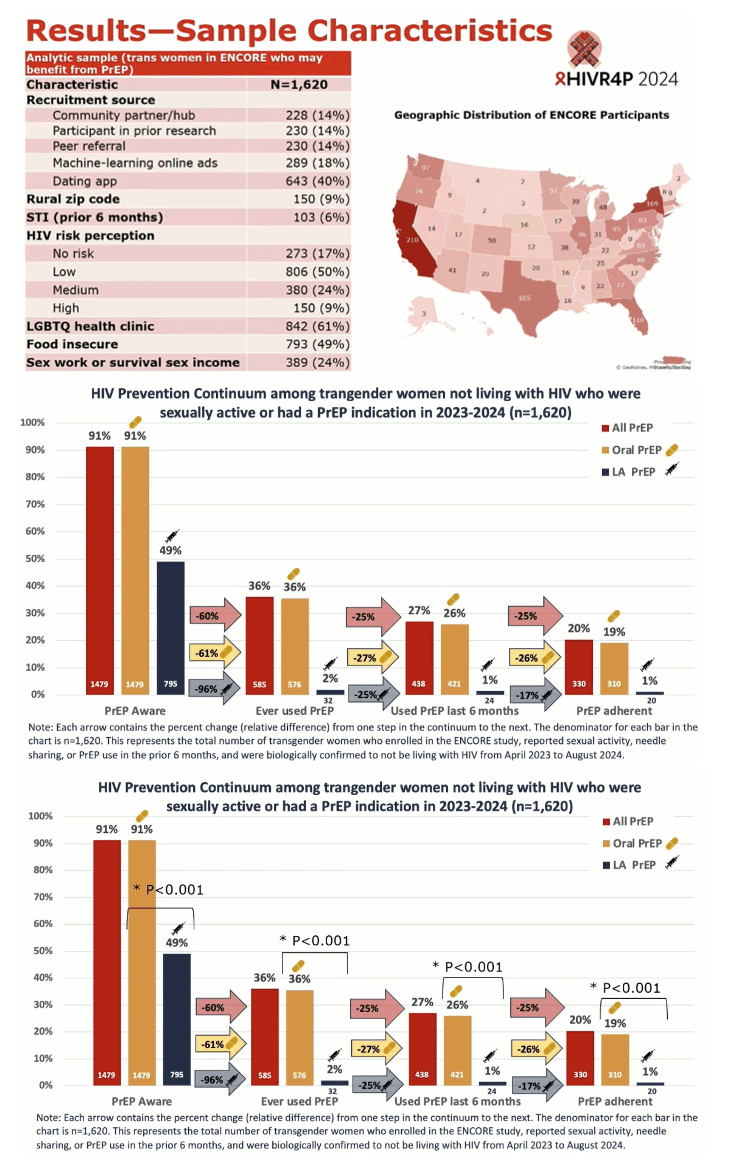
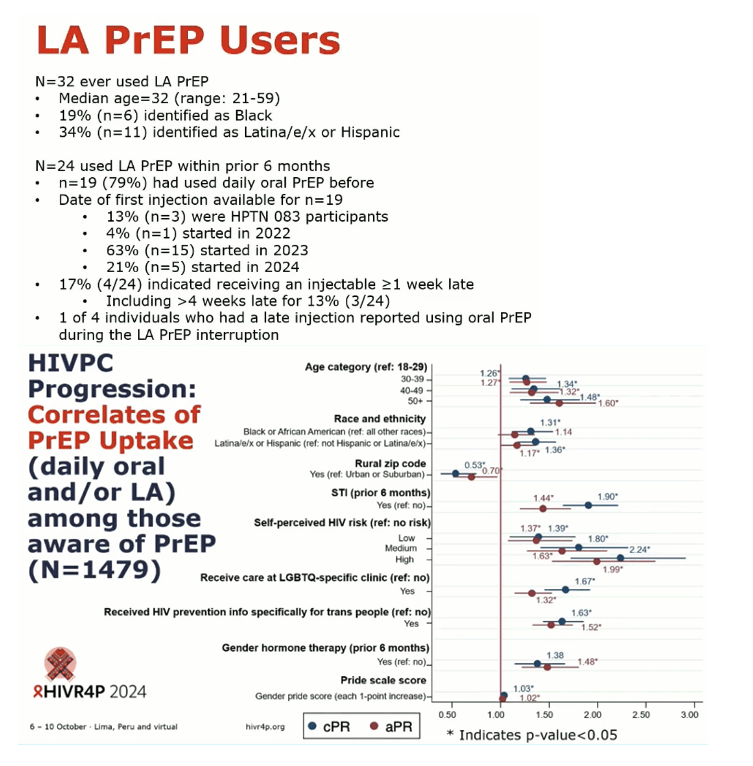
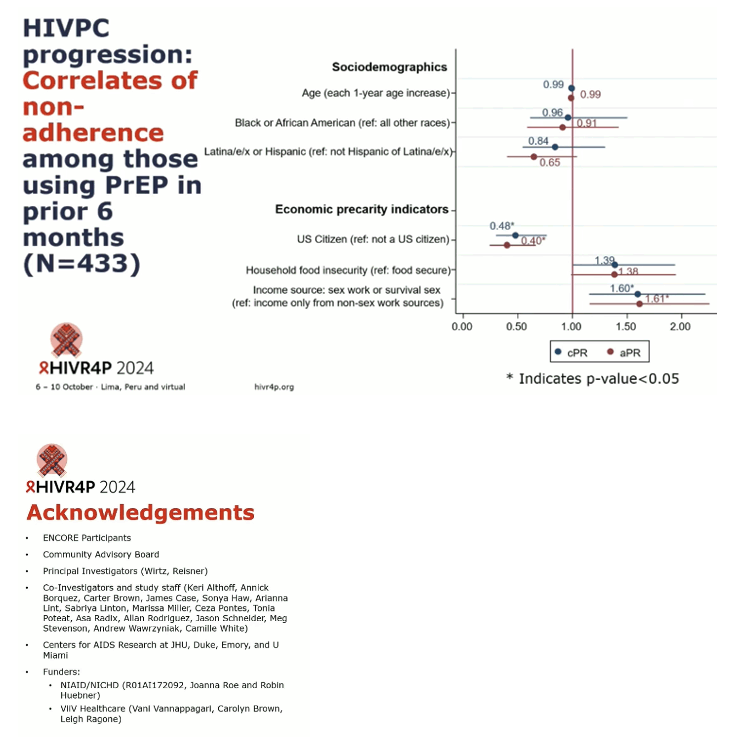
|
| |
|
 |
 |
|
|